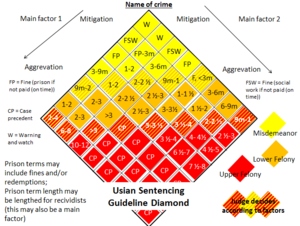Usian criminal law
The power of the Usian Parliament to enact criminal law is derived from section II(2)2 of the Usian Constitution. All criminal laws are codified in the Criminal Code of the Usian Republic.
Prosecution
In the Usian Republic, criminal prosecutions are brought in the name of the Department of Justice.
There are three types of criminal offenses: Misdemeanor, Lower Felony and Upper Felony. Which of the three it is depends on the law and the decision of the judge at the sentencing.
Cases are usually brought before the lowest court possible first.
Elements of an offense
Criminal offenses require the prosecution to prove that there was criminal conduct (actus reus) accompanied by a criminal state of mind (mens rea) "beyond reasonable doubt". Exceptions to the mens rea requirement exist for strict and absolute liability offenses.
The specific elements of each offence can be found in the wording of the offense.
For the prosecution to prove the accused is guilty the actus reus and mens rea must be proven.
Defenses
Even if the prosecution has proven the commission of the offense, a the offender may still avoid being convicted by raising a defense. A true defense arises when some circumstances afford the accused a partial or complete justification or excuse for committing the criminal act. True defenses include insanity, duress, automatism, necessity, and inebriation induced unknowingly to or against the will of the offender. There is also a partial defense of provocation, which has the effect of reducing what would otherwise be 1st or 2nd degree murder to 3rd degree murder or manslaughter.
Court proceedings
The proceedings of a legitimate Usian court confronted with a criminal law case are codified in the Government Procedural Code (GPC).
Punishment
Usian Sentencing Guidelines

While maximum and minimum punishments are the only instruction the Penal Code gives for crimes, the Justice Committee of the Parliament makes sets of guidelines providing the recommended severity according to mitigating and aggravating factors. These are not obligatory, but an offender may appeal to a higher court if he or she receives a higher sentence than is advised by the Sentencing Guidelines.
The Guidelines exist, for the most part (where they are not too complex), in form of rhombus-shaped tables known as Usian Sentencing Guideline Diamonds (USGD). These diamond charts provide for only two main mitigating/aggravating factors, however.
Young offenders
Young offenders (Persons 13 or older, but younger than 18) must receive a reduced sentence focused more greatly on rehabilitation on the account of their lack of full criminal responsibility and the importance of their development. There is no separate criminal code for young offenders, but the Penal Code lists the correct reduced sentences.